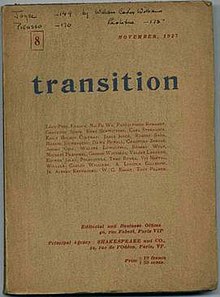Transition (literary journal)

Cover of Issue 8 of literary magazine transition from November 1927
|
|
| Editor | Eugene Jolas |
|---|---|
| Categories | Literary journal |
| Frequency |
Monthly (April 1927-March 1928) |
| Circulation | 1000+ |
| First issue | April 1927 |
| Final issue — Number |
Spring 1938 27 |
| Country | France |
| Based in | Paris, then Colombey-les-deux-Eglises |
| Language | English |
Monthly (April 1927-March 1928)
transition was an experimental literary journal that featured surrealist, expressionist, and Dada art and artists. It was founded in 1927 by poet Eugene Jolas and his wife Maria McDonald and published in Paris. They were later assisted by editors Elliot Paul (April 1927- March 1928), Robert Sage (October 1927-Fall 1928), and James Johnson Sweeney (June 1936-May 1938).
The literary journal was intended as an outlet for experimental writing and featured modernist, surrealist and other linguistically innovative writing and also contributions by visual artists, critics, and political activists. It ran until spring 1938. A total of 27 issues were produced. It was distributed primarily through Shakespeare and Company, the Paris bookstore run by Sylvia Beach.
While it originally almost exclusively featured poetic experimentalists, it later accepted contributions from sculptors, civil rights activists, carvers, critics, and cartoonists. Editors who joined the journal later on were Stuart Gilbert, Caresse Crosby and Harry Crosby.
Published quarterly, transition also featured Surrealist, Expressionist, and Dada art. In an introduction to the first issue, Eugene Jolas wrote:
Of all the values conceived by the mind of man throughout the ages, the artistic have proven the most enduring. Primitive people and the most thoroughly civilized have always had, in common, a thirst for beauty and an appreciation of the attempts of the other to recreate the wonders suggested by nature and human experience. The tangible link between the centuries is that of art. It joins distant continents in to a mysterious unit, long before the inhabitants are aware of the universality of their impulses....
We should like to think of the readers as a homogeneous group of friends, united by a common appreciation of the beautiful, - idealists of a sort, - and to share with them what has seemed significant to us.
...
Wikipedia
